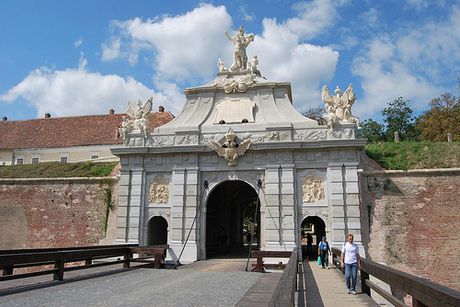Princely Palace
The Princely Palace, built in the 16th century, was Prince Mihai Viteazul’s residence during the first political unification of Romanians in the 1600s. Following Ottoman and Tatar invasions the palace was destroyed. During the rule of princes Gábor Bethlen and George II Rakoczi the palace was restored but not to its previous condition. From 1700 on, the building was used as military barracks.
Opposite the palace is the Union Hall (Sala Unirii), where the unification act between Romania's other historical provinces and Transylvania was signed during the Great Assembly of December 1st 1918.
The Princely Palace (Palatul Principilor or Palatul Voievodal) was Michael the Brave's residence during the first political unification of the Romanians in 1600. Foreign chronicles pictured it as an extremely luxurious building, richly adorned with frescos and marble stairs, ; later deteriorated. During the rule of Princes Gábor Bethlen and George II Rákóczi the second palace was restored, but not to its previous condition. After 1716, the building was used as an Habsburg Imperial Army barracks.
Michael the Brave or Mihai Bravu was the Prince of Wallachia (1593–1601), of Transylvania (1599–1600), and of Moldavia (1600), the three Romanian principalities being joined under his reign for a short period of time.
During his reign, which coincided with the Long War, these three principalities forming the territory of present-day Romania and Republic of Moldova were ruled for the first time by a single Romanian leader, though the union lasted for less than six months. He is regarded as one of Romania's greatest national heroes.
His rule began in the autumn of 1593, and two years later the war with the Ottomans started, a conflict in which the Prince fought the Battle of Călugăreni, considered one of the most important battles of his reign. Although the Wallachians emerged victorious from the battle, Michael was forced to retreat with his troops and wait for aid from his allies (prince Sigismund Báthory of Transylvania, Emperor Rudolf II of Austria). The war continued until a peace finally emerged in January 1597, but this only lasted for a year and a half. Peace was again reached in late 1599, when Michael was unable to continue the war due to lack of support from his allies.
In 1599 Michael won the Battle of Şelimbăr and soon entered Alba Iulia, becoming the Prince of Transylvania. A few months later, Michael's troops invaded Moldavia and reached its capital, Suceava. The Moldavian leader Ieremia Movilă fled to Poland and Michael was declared Prince of Moldavia. Michael kept the control of all three provinces less than a year. The nobles of Transylvania rose against him along with, to a lesser extent, some boyars from Moldavia and Wallachia. Therefore, Michael allied with the Austrian General Giorgio Basta, defeated an uprising of the Hungarian nobility at Gurăslău in Transylvania. Immediately after this, Basta ordered the assassination of Michael, which took place on 9 August 1601.
The Palace is opened for touring. Guides are available online and tourists can get information about the town and the region on the tourist bureaus at the main international airports all around the country.




